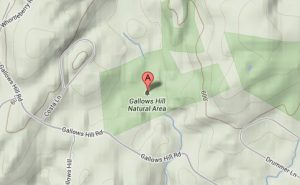 During the winter of 1778-1779 General Israel Putnam and about 3,000 troops of the Continental Army encamped in Redding, Connecticut. The harsh winter brought a rash of problems, from illness and low food supplies to the more problematic issues of desertions and theft.[1]
During the winter of 1778-1779 General Israel Putnam and about 3,000 troops of the Continental Army encamped in Redding, Connecticut. The harsh winter brought a rash of problems, from illness and low food supplies to the more problematic issues of desertions and theft.[1]
Indeed Tory spies frequently penetrated Putnam’s lines, carrying information to the British. Putnam decided examples needed to be made of the first spy or deserter caught. In February, Edward Jones and John Smith, both born in Britain, became those examples when they were executed on the same day on a site remembered as Gallows Hill.[2]
Today visitors to Putnam’s encampment, the present day Putnam State Park, can take a self-guided tour that explains the placement of soldiers’ huts, storehouses and more. However, for anyone curious to see where the executions took place, one must leave the park. Gallows Hill actually lies about a mile and a half from where the main camp stood, just east of the present day intersection of the aptly names Gallows Hill Road and Whortleberry Road. One has to imagine away the second growth forest that now covers the terrain for at the time of the execution few, if any, trees stood.[3] In 1779 the land, formed a natural amphitheater. This allowed the soldiers from all three camps and the townspeople to watch the proceedings.
Born in Wales, Jones’ loyalty to King George III remained steadfast. He lived in Ridgefield until the British occupied New York. Jones decided to flee to New York and live under British protection. Jones became a butcher and bought meat to British troops billeted in Westchester, NY. According to the courts-martial Jones supplied fresh meat and produce as well as fresh intelligence. Arrested in Ridgefield for spying on Putnam’s camp Jones told his captors he’d simply gotten lost.
Smith, like Jones, hailed from Great Britain. He served with the 1st Connecticut Battalion but was accused of planning to join the British army as a Tory convert. During his court-martial he said he’d do it all over again. Subsequently he was found guilty of deserting and attempting to go to the enemy.
Putnam decided, “to make a double job of it” to impress upon his troops the consequences of desertion. Because it was a public execution the civilian population was expected to watch as well.
After the courts-martial rendered its verdict, Jones and Smith were imprisoned in a saltbox house on Umpawaug Hill in Redding. The house, which once belonged to the Barlow Family, no longer stands. Townspeople jeered the two men. Putnam finally ordered people to stay away from the house after complaints that the taunts prevented the condemned from praying.
Both verdicts were met with protest. Reverend Nathaniel Bartlett, the local chaplain, pushed for a stay of execution. That Smith was just 17-years-old troubled Bartlett, so he asked Putnam to consult with General George Washington before carrying out the execution. Putnam denied his request. Moreover, Bartlett delivered a sermon regarding the prisoners the day of the execution.
On 16 February 1779, troops led Jones and Smith to a clearing, which would afterwards bear the name Gallows Hill. The Connecticut troops stood in a line along the natural amphitheater and flanked the fatal spot. The gallows was said to stand 20 feet high. A ladder led to the noose. Jones climbed it and General Putnam ordered the ladder to be turned over. Then it came time for Smith. Troops half dragged him to a spot just about 200 yards from where Jones was hanged. The firing squad unloaded 23 musket balls near point-blank range. His clothing caught fire. His body was placed into a coffin – every soldier had to march by and view remains.[4]
[1] Martin, Joseph Plumb, Pvt. “Selections from the Diary of Private Joseph Plumb Martin.” See also Martin, Joseph Plumb. “A Narrative of a Revolutionary Soldier: Some Adventures, Dangers, and Sufferings of Joseph Plumb Martin.” Signet Classics: Reprint edition. June 2010.
[2] Grumman, William Edgar. Revolutionary Soldiers of Redding, Connecticut and the Record of their Services. Hartford, CT: Case, Lockwood & Brainard Company, 1904.







Recent Articles
Supplying the Means: The Role of Robert Morris in the Yorktown Campaign
Revolution Road! JAR and Trucking Radio Legend Dave Nemo
Those Deceitful Sages: Pope Pius VI, Rome, and the American Revolution
Recent Comments
"Texas and the American..."
Mr. Villarreal I would like to talk to you about Tejanos who...
"Trojan Horse on the..."
Thank you Eric! I should say that I have enjoyed your work...
"Trojan Horse on the..."
Great article. Love those events that mattered mightily to participants but often...